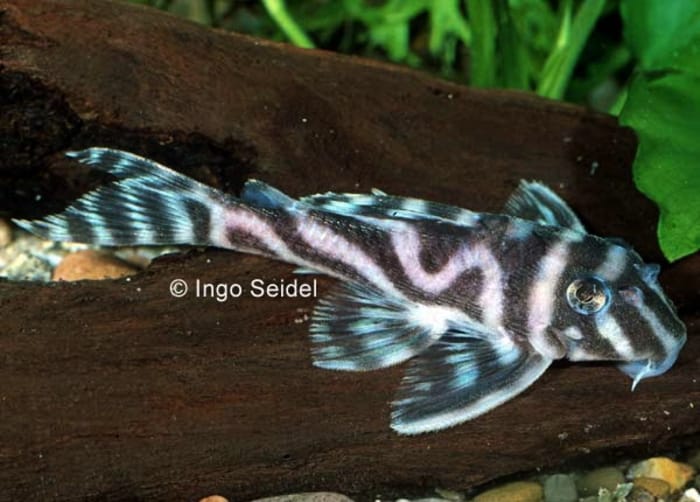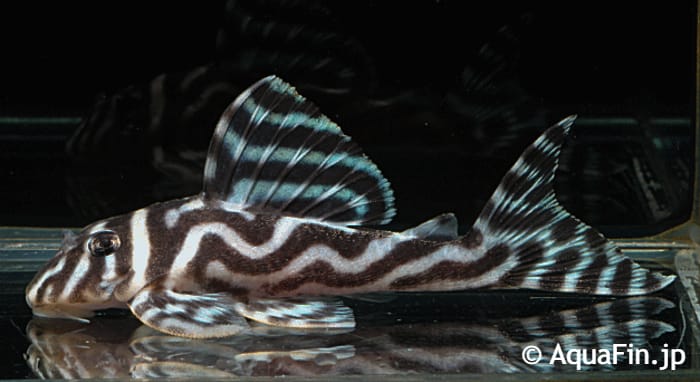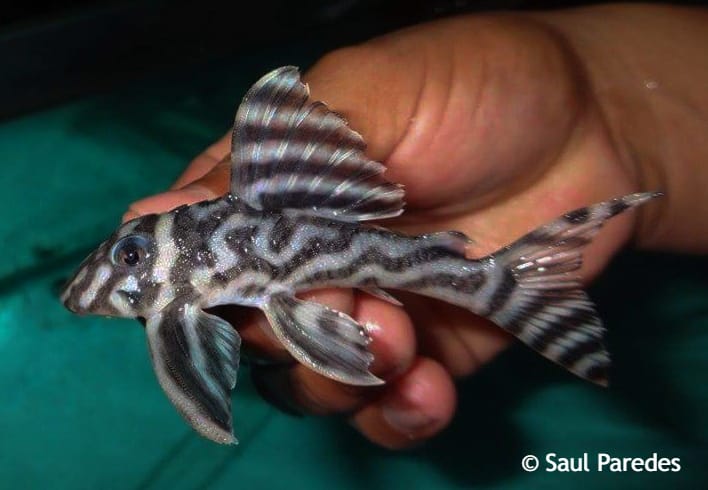







It’s quite amazing that a Pleco can end up looking like Hypancistrus zebra. It’s no less amazing that there’s another form of Hypancistrus in Rio Xingu, Brazil trying to benefit from looking the same way! L173 was (and still is by many) actually thought to be a form of H.zebra with wavy lines, but it’s not – although there are indeed also specimens of H.zebra with aberrant pattern in the river too (L98 and L250 are examples of this). L173 is indeed a different species, and it’s an extremely rare morph of possibly H.seideli (L66, L333, L399 and L400). To the best of my knowledge, their location in the river (if there is a particular one?) is a well-guarded secret, meaning that even local scientists haven’t been able to track them down to investigate their DNA. It’s not allowed for export from Brazil, so captive breeding programs are necessary if we are to enjoy its existence in the hobby. It’s a hardy and easy to care for species when well settled in the aquarium.
Facts:
Name: Hypancistrus cf. seideli (Sousa, Sousa, Ribeiro, Sabaj, Zuanon & Py-Daniel, 2025)
Trade names: False Zebra Pleco, Wavy-Line Zebra Pleco, L173
Origin: Rio Xingu, Brazil
Maximum size: 12 cm / 5”
Much like with L236, L173 is now more of a definition of pattern than of a certain “species”. It can be quite hard sometimes to say where the line is drawn between what is a L173 and what is a L400, because you can find specimens with a pattern that is just wormlined enough to say it’s more like L400 than L173. On the other hand, you can find specimens of L173 with lines straight enough to make it almost comparable to H.zebra. However, compared to H.zebra L173 is a bigger fish when adult. It has a higher back, longer caudal fin and usually less straight black lines – at least when adult. L173 often has a slightly more beige bodycolour than the pure white H.zebra. But most importantly, L173 has brown eyes, H.zebra has silver or blue eyes. The variability of L173 is interesting and it seems like the zebra pattern is not very well defined in their genes, so offspring may not always look as much like H.zebra as their parents do. This is possibly because L173 is a morph of H.seideli. Clearly the rapids of Xingu make room for local adaptations and variations in appearance, although the variation is unusually remarkable within the wormlined Hypancistrus. There seems to be some possible mimicry of H.yudja (L174) in the form of L470 and H.zebra in the form of L173 going on. The true, wild type of L173 is a very sought after fish, and most of the public don’t understand the variability hiding beneath their skin. This leads to unfortunate and heated debates and accusations. In addition, captive breeding programs mixing in L46 with lines of L173 to make them more “zebra-like” has added to the confusion. There are also lines marketed as L173B or L173 “Glaser”, which are much more like L399 and L400 in their appearance, hence commanding lower market prices.
As with other Hypancistrus from Rio Xingu, L173 needs an aquarium set up consisting of lots of hiding places in the form of rocks, wood and of course specially made caves that suit their measurements. In these the males will eventually guard their offspring. They prefer water that is warm (27-30 C), soft and slightly acidic. Most of all it should be well oxygenated and clean, so a good filtration system and frequent water changes are essential. Among themselves they are peaceful, although males may quarrel for caves and females can sometimes be badly injured or even killed during the breeding-trapping in the male’s cave. Males develop longer odontodes on their pectoral fins and on their cheeks and have broader heads. Hypancistrus are mostly carnivorous, so a selection of crustaceans, insect larvae and fish meat should be offered along with high quality dried foods that also contain some vegetable matter.
More info:
